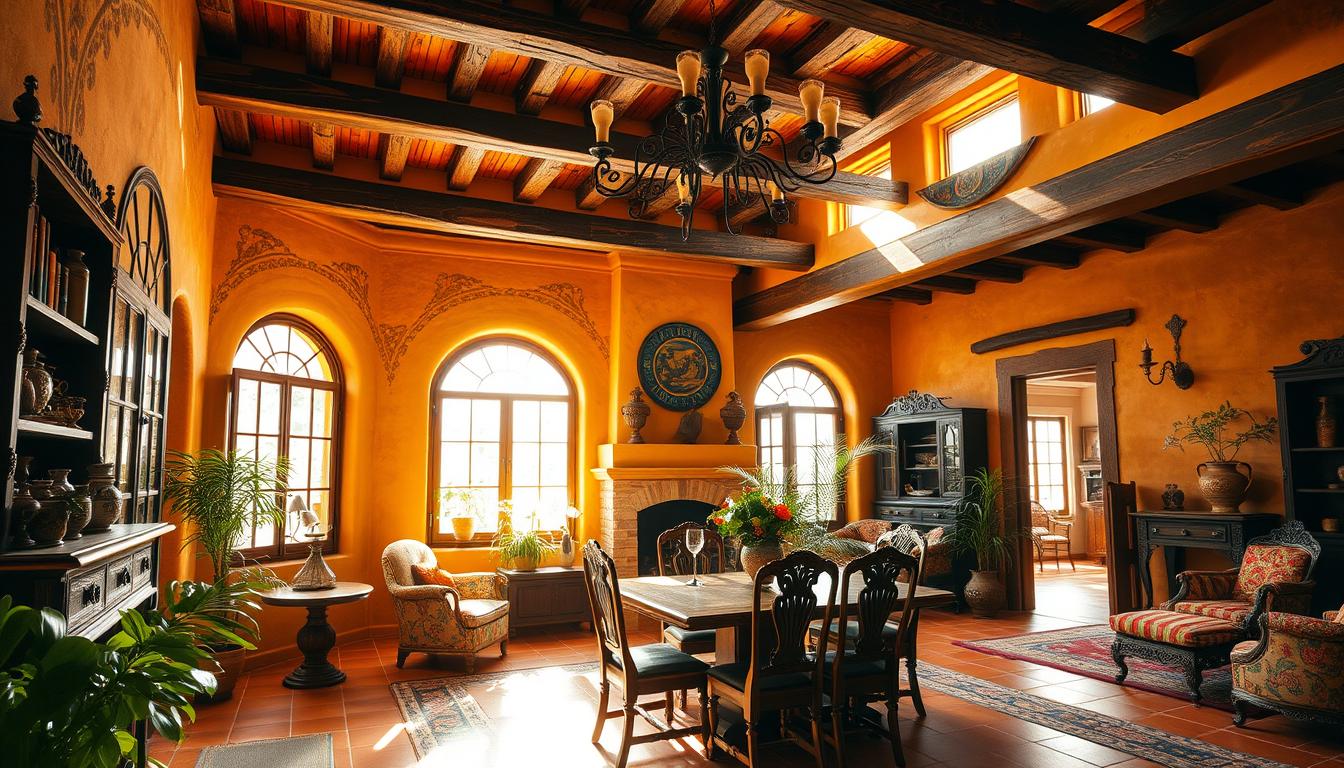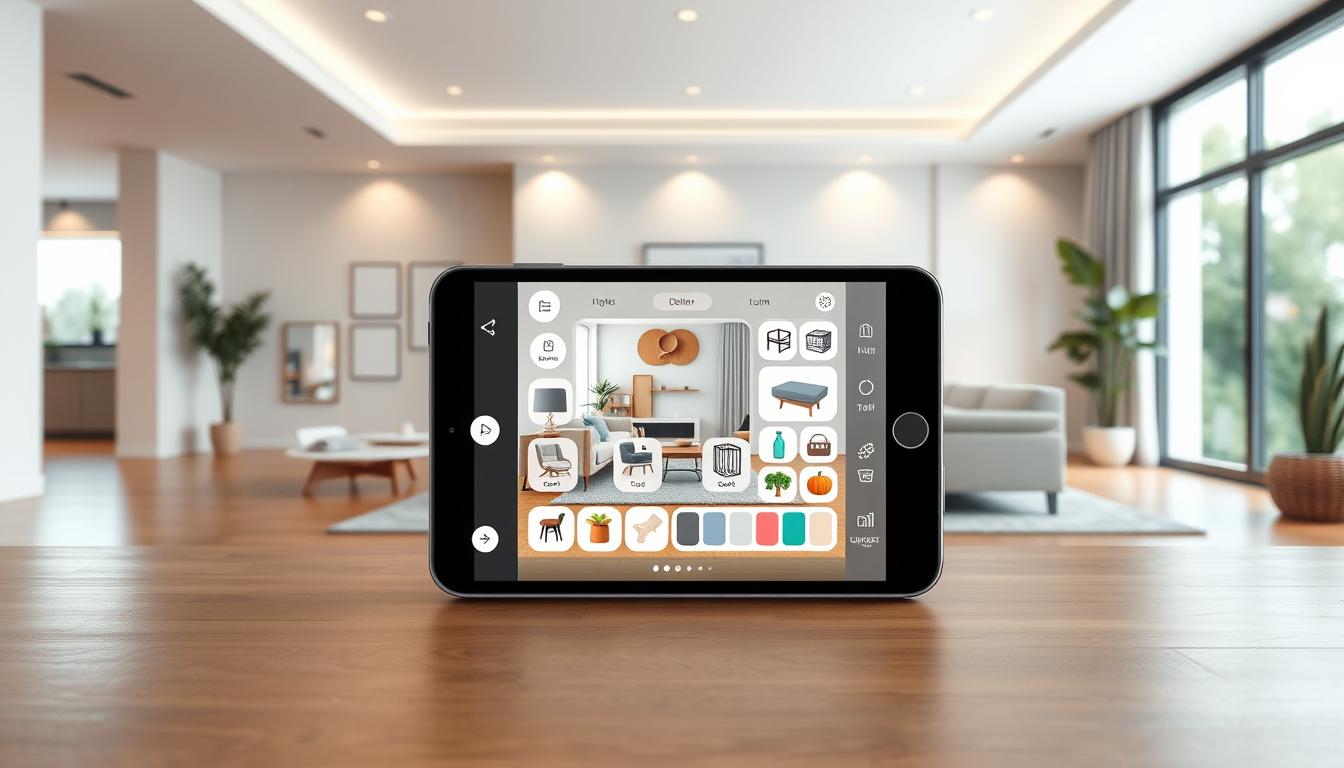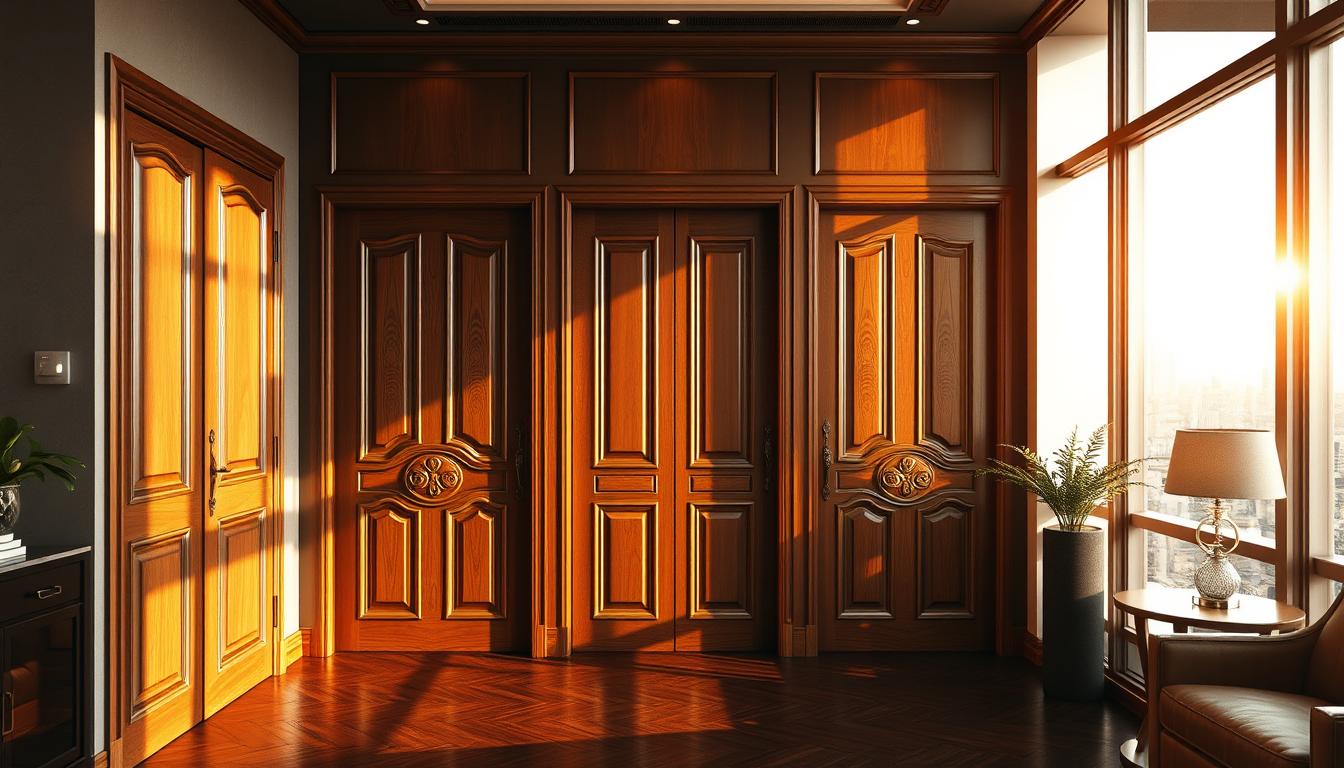Did you know that Spanish-style homes are very popular in the United States? They are known for their warm, welcoming spaces and bright, lively colors. These homes bring a sense of history and culture into your home.
We will look at the main features of Spanish architecture. This includes colors, textures, and materials. We will also cover important furniture and lighting choices. Whether you want a traditional Spanish-style interior or just some Spanish touches, this guide will help you start.
Key Takeaways
- Understand the key characteristics of Spanish-style home interiors
- Learn how to incorporate Spanish elements into your existing décor
- Discover essential furniture and lighting solutions for a Spanish-style home
- Explore color palettes, textures, and materials typical of Spanish architecture
- Create a warm and inviting atmosphere in your home
Understanding Spanish-Style Home Interiors
Spanish-style interiors mix rustic charm with Mediterranean elegance. This unique blend makes Spanish homes warm and inviting. They are both traditional and timeless.
To get this look, knowing Spanish architecture and design is key. Rustic elements like wooden beams, terracotta tiles, and stucco walls are essential. They create an authentic Spanish-style interior.
Key Characteristics of Spanish Architecture
Spanish architecture uses strong, natural materials. This gives Spanish homes a warm, earthy feel. Key features include:
- The use of terracotta tiles for roofing, adding rustic charm.
- Wooden beams that are often exposed, enhancing the rustic look.
- Stucco walls for a smooth, textured finish.
- Arches and domed ceilings, showing Mediterranean influence.
Experts say, “Spanish architecture focuses on natural materials and texture.”
“Spanish architecture is not just about looks; it’s about warmth and community.”
| Characteristic | Description | Example |
|---|---|---|
| Rustic Elements | Use of natural materials | Wooden beams, terracotta tiles |
| Mediterranean Influence | Incorporation of arches and domes | Arched doorways, domed ceilings |
| Traditional Furnishings | Use of antique and rustic furniture | Ornate wood furniture, vintage textiles |
Historical Influences on Spanish Design
Spanish design has been shaped by cultures like the Moors and Romans. These influences are seen in arches, domed ceilings, and intricate tile work.
These elements add depth and character to Spanish interiors. They also honor Spain’s rich cultural heritage.
By understanding and using these elements, you can make a Spanish-style home interior that’s both authentic and welcoming.
Color Palettes That Define Spanish Interiors
Spanish interiors are known for their warmth and vibrancy. This comes from choosing colors that show Spain’s rich culture. The right color palette makes a space feel warm and welcoming.
Warm earth tones are a big part of Spanish design. They remind us of Spain’s sunny landscapes. These colors make a space feel cozy and inviting.
Warm Earth Tones and Their Impact
Colors like terracotta, sienna, and golden brown are common in Spanish interiors. They bring the Spanish countryside into your home. These colors are used in:
- Wall finishes
- Flooring
- Decorative accents
They help blend indoor and outdoor spaces, a key feature of Spanish homes. Using these warm tones also lets you add natural materials. This makes the space feel more organic.
Vibrant Accents: Blues and Terracottas
Vibrant colors like blues and terracottas are also important in Spanish interiors. They add a splash of color and interest. These colors are often seen in:
- Ceramics and pottery
- Textiles like rugs and throw pillows
- Decorative tiles
Combining warm earth tones with vibrant colors creates a rich, Spanish color palette. This mix adds depth and shows off Spain’s cultural and historical influences.
Choosing the right colors is key to creating a Spanish-style interior. It makes your space feel authentic and welcoming. Whether you’re updating or designing a new home, understanding color is crucial for the right look.
Embracing Textures and Materials
Choosing the right textures and materials is key for a genuine Spanish-style interior. It should feel both elegant and earthy. Natural and rustic elements add warmth and authenticity to the space.
The Role of Adobe and Stucco
Adobe and stucco are essential in Spanish-style architecture. They give a rustic, earthy feel. Adobe’s thick walls make a space feel solid and historic. Stucco adds texture and can be finished in many ways for different looks.
Benefits of Adobe and Stucco:
- Durability: Both adobe and stucco are durable and can handle different weather conditions.
- Aesthetic Versatility: They can be finished in many ways, from smooth to textured, for various looks.
- Thermal Mass: Adobe is valued for its ability to help regulate indoor temperatures.
Incorporating Wood and Wrought Iron
Wood and wrought iron are vital in Spanish-style interiors. They add warmth and character. Wooden beams, doors, and furniture make a space cozy. Wrought ironwork, like in lighting and railings, adds elegance and sophistication.
| Material | Characteristics | Uses |
|---|---|---|
| Wood | Warmth, natural grain | Furniture, beams, doors |
| Wrought Iron | Elegant, durable, versatile | Lighting, railings, decorative accents |
Design experts say, “Mixing natural materials like wood and wrought iron with earthy textures like adobe and stucco is crucial for an authentic Spanish-style interior.” This mix honors Spanish design traditions and makes a space welcoming and sophisticated.
“The beauty of Spanish-style design lies in its ability to blend rustic elements with elegant finishes, creating a unique and captivating aesthetic.”
Essential Furniture for Spanish-Style Spaces
Furniture is key in making a Spanish-style home look its best. It ranges from old pieces to new takes on classic designs. The right furniture can make you feel like you’re in Spain, bringing warmth and elegance into your home.
Heirloom Pieces: Antique and Rustic Finds
Antique and rustic furniture are must-haves for Spanish-style homes. These heirloom pieces add history and realness to your space. Look for wooden furniture with detailed carvings, pieces with worn finishes, and metalwork with intricate designs.
These items can make your home feel richer and more interesting.
Some top picks include:
- Ornate wooden armchairs
- Distressed wooden beams
- Wrought iron furniture
Modern Twists on Traditional Designs
Spanish-style interiors often feature traditional furniture, but adding modern touches keeps things fresh. You can mix old pieces with new furniture or update classic designs with new materials. This mix of old and new creates a unique and eye-catching look that stays true to Spanish style.
Here are some ideas for modernizing traditional furniture:
- Reupholstering antique furniture with modern fabrics
- Pairing traditional wooden pieces with modern metal or glass accents
- Incorporating modern lighting fixtures into traditional settings
By combining traditional and modern furniture, you can make a Spanish-style space that’s both genuine and stylish.
Lighting Solutions: Setting the Mood
In Spanish-style interiors, lighting is more than just functional. It’s an art that makes the space warm and inviting. Good lighting can show off architectural details, create cozy spots, and change the feel of a room.
Using Chandeliers and Pendant Lights
Chandeliers and pendant lights bring elegance to Spanish-style homes. Chandeliers can make a big impact in entryways or dining rooms. On the other hand, pendant lights add warmth over kitchen islands or in cozy reading spots.
When picking chandeliers or pendant lights, look for designs with Spanish tiles or wrought iron. These features keep the Spanish look alive and connect the lighting to the interior design theme.
Natural Light and Window Treatments
Natural light is key in Spanish-style homes, bringing warmth and comfort. Big windows and sliding glass doors let in lots of natural light. This makes rooms feel more open and airy.
Choosing the right window treatments is important to keep the Spanish style while controlling light. Wooden shutters and heavy drapes are classic choices. They add to the cozy feel and let you adjust the light as needed.
The Importance of Outdoor Spaces
Spanish-style homes are special because they blend indoor and outdoor living. This creates a peaceful and Mediterranean-inspired setting. Outdoor areas are key, making the transition from inside to outside smooth.
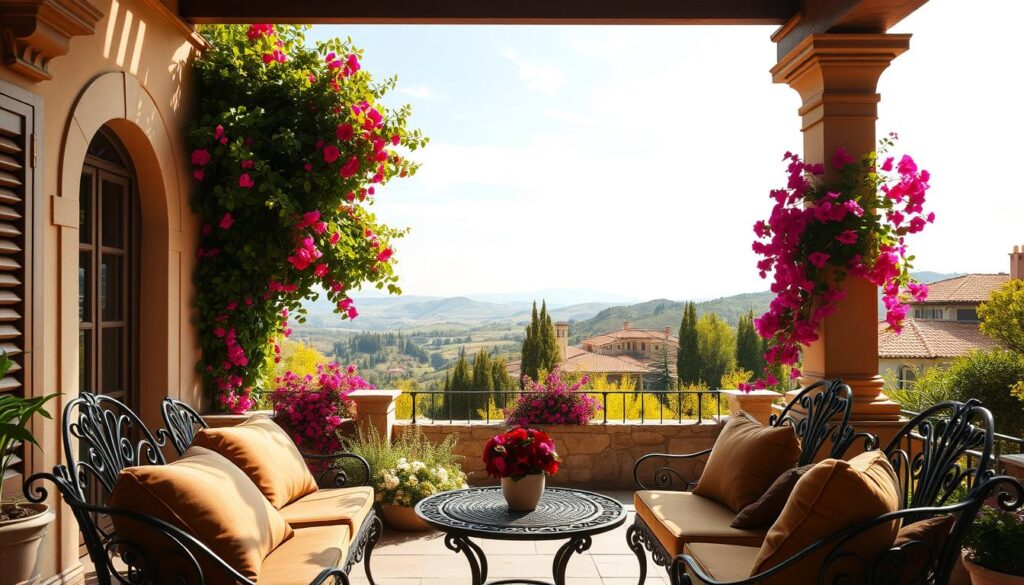
Incorporating Patios and Courtyards
Patios and courtyards are essential in Spanish homes. They offer a calm spot for relaxation and socializing. These spaces often feature traditional Spanish elements like fountains, archways, and detailed tile work.
To add patios and courtyards to your home, use natural materials like stone and stucco. Decorate with wrought iron furniture and colorful pottery. This will make your space feel both genuine and welcoming.
Garden Elements That Enhance Spanish Style
Garden elements are vital in enhancing Spanish outdoor spaces. Adding Mediterranean plants like olive trees, lavender, and rosemary brings authenticity and scent. Terracotta pots and traditional Spanish garden ornaments also boost the Mediterranean vibe.
- Olive trees for a classic Mediterranean touch
- Terracotta pots to add warmth and color
- Wrought iron garden furniture for a traditional look
By carefully choosing these elements, you can make outdoor spaces that are not just beautiful. They also capture the warm and inviting essence of Spanish-style homes.
Accessories That Elevate Spanish Interiors
Spanish-style homes are known for their warm, inviting atmospheres. This is thanks to the thoughtful use of accessories like pottery and textiles. These elements add visual interest and create a welcoming environment that reflects the culture’s heritage.
Pottery and ceramics are key to infusing a Spanish-style home with authenticity. These pieces are both functional and decorative. They add warmth and character to a room.
Pottery and Ceramics for Authenticity
Pottery and ceramics are a big part of Spanish craftsmanship. Many artisans use traditional techniques passed down through generations. Adding these pieces to your décor can make your home feel more authentic.
Some popular types of pottery and ceramics include:
- Hand-painted ceramics from regions like Valencia and Catalonia
- Terracotta pots and vases, which can add a rustic touch to a room
- Decorative plates and platters, which can be used to add visual interest to a wall or table
Textiles also play a big role in Spanish-style interiors. Rugs, pillows, and throws add color, texture, and warmth to a space.
Textiles: Rugs, Pillows, and Throws
Spanish-style interiors often feature vibrant colors and rich patterns. Consider incorporating:
- Moroccan-inspired rugs, which can add a pop of color and texture to a room
- Pillows and throws in bold, vibrant hues, which can be used to add visual interest to a sofa or armchair
- Natural fibers like wool and cotton, which can add warmth and coziness to a space
| Textile | Description | Benefits |
|---|---|---|
| Rugs | Moroccan-inspired patterns, vibrant colors | Adds warmth, texture, and visual interest |
| Pillows and Throws | Bold, vibrant hues, natural fibers | Adds color, texture, and coziness |
| Natural Fibers | Wool, cotton, linen | Provides warmth, durability, and a natural look |
As the famous Spanish architect, Antoni Gaudí, once said, “The arts and crafts are the essence of a culture, and they are what make it unique.” By using pottery, ceramics, and textiles in your home, you can create a space that truly reflects the culture’s rich heritage.
“The ornamentation is not just an embellishment, it is a language, a means of expression.”
Creating a Cohesive Spanish Aesthetic
To make your home look Spanish, mix old and new styles. This mix is key for a welcoming space that shows off Spanish culture.
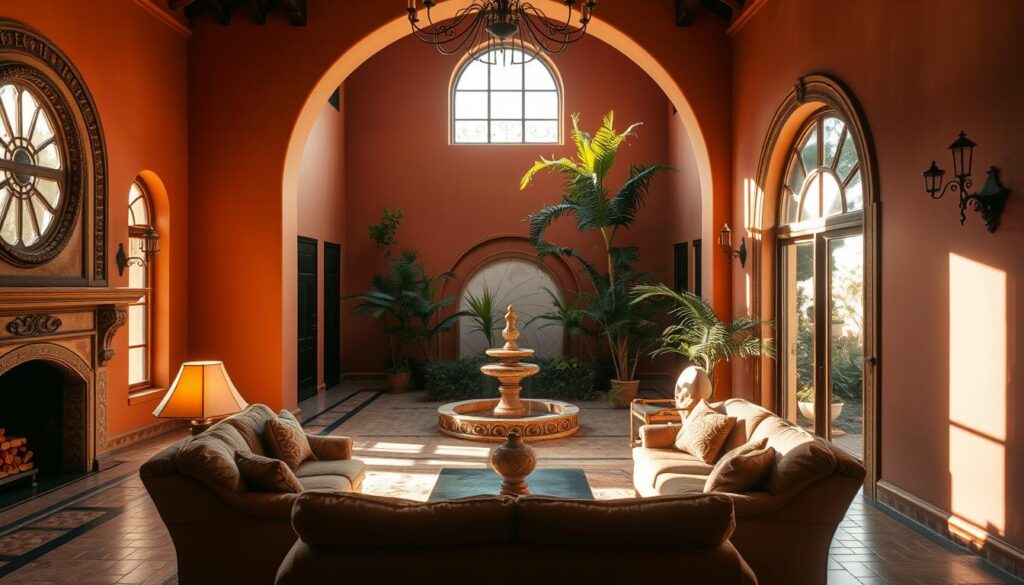
Balancing Traditional and Contemporary Elements
It’s important to blend traditional Spanish features like arched doorways and wooden beams with modern decor. Choose modern items that match the look and feel of Spanish design.
A modern sofa in a simple color can go well with old wooden furniture. This mix of old and new looks great. Also, using textiles with traditional Spanish patterns adds warmth and depth.
Color Coordination Across Spaces
Keeping colors consistent is crucial for a unified look. In Spanish homes, warm earth tones like terracotta and golden brown are common. These colors tie rooms together and reflect the Spanish landscape.
Start with a main color scheme and stick to it. Then, add vibrant accents like blues and yellows to make each room unique. For example, a terracotta tile in the kitchen can match the living room’s colors, creating a smooth flow.
By balancing old and new and matching colors, you can make your home look Spanish. This makes your home both beautiful and functional.
Common Pitfalls to Avoid in Spanish Design
To truly capture the essence of Spanish style, one must be mindful of the fine line between authenticity and overwhelm. While it’s tempting to fill your home with rustic elements and traditional furnishings, doing so without balance can lead to a space that feels cluttered and overwhelming.
When it comes to Spanish design, two common pitfalls can make or break the aesthetic: overdoing it with color and neglecting functionality for the sake of aesthetics. Let’s dive into these challenges and explore how to avoid them.
Overdoing Color: Finding the Right Balance
Spanish interiors are known for their vibrant colors, from the warm terracottas to the deep blues. But, it’s easy to get carried away with these hues. To avoid overwhelming the senses, it’s crucial to strike a balance between bold colors and neutral tones.
Consider using a dominant neutral color for larger elements like walls and furniture, and then incorporate bolder colors through accents like pottery, textiles, and artwork. This approach allows you to enjoy the vibrancy of Spanish colors without overwhelming the space.
Neglecting Functionality in Favor of Aesthetics
While aesthetics play a significant role in Spanish design, functionality should not be sacrificed. It’s essential to incorporate pieces that are not only beautiful but also serve a purpose. For instance, a beautifully crafted wooden chest can be used for storage, combining form and function.
To achieve this balance, consider the flow and functionality of each room. Ensure that decorative elements do not hinder the usability of the space. By doing so, you’ll create a home that is both visually appealing and livable.
Inspiration: Famous Spanish-Style Homes
California is a treasure trove for those who love Spanish-style home interiors. The state is filled with stunning examples of Spanish design. You’ll find everything from grand estates to cozy haciendas.
Notable Examples from California
California boasts many iconic Spanish-style homes. These homes mix traditional charm with modern luxury perfectly. They often have adobe walls, curved lines, and beautiful tile work.
These classic features create a welcoming atmosphere. For more décor ideas, checking out these homes is a great idea. It can help you design your own Spanish-style home.
Influential Designers and Their Contributions
Influential designers have greatly influenced the Spanish-style aesthetic. They’ve combined timeless elements with a modern twist. Their work has made this style popular among homeowners.

